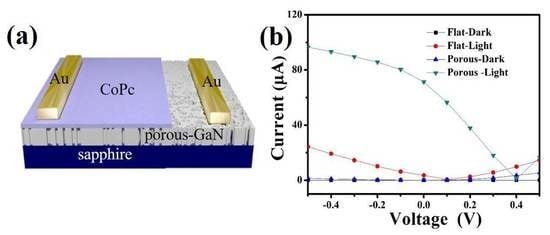High-Performance Self-Powered Ultraviolet Photodetector Based on Nano-Porous GaN and CoPc p–n Vertical Heterojunction
Abstract
:1. Introduction
2. Materials and Methods
2.1. Materials and Chemicals
2.2. Preparation of Nanoporous GaN
2.3. Device Fabrication
2.4. Characterization
3. Results
3.1. Microstructures of the Nanoporous GaN and CoPc/Porous-GaN Film
3.2. Optical Properties of the Nanoporous GaN and CoPc/Porous-GaN Film
3.3. Device Characterization
3.4. Sensing Mechanism
3.5. Performance Enhancement Mechanism
4. Conclusions
Supplementary Materials
Author Contributions
Funding
Conflicts of Interest
References
- Khan, F.; Khan, W.; Kim, S.D. High-Performance Ultraviolet Light Detection Using Nano-Scale-Fin Isolation AlGaN/GaN Heterostructures with ZnO Nanorods. Nanomaterials 2019, 9, 440. [Google Scholar] [CrossRef] [PubMed]
- Kim, Y.; Kim, S.J.; Cho, S.P.; Hong, B.H.; Jang, D.J. High-performance ultraviolet photodetectors based on solution-grown ZnS nanobelts sandwiched between graphene layers. Sci. Rep. 2015, 5, 12345. [Google Scholar] [CrossRef] [PubMed] [Green Version]
- Anitha, R.; Ramesh, R.; Loganathan, R.; Vavilapalli, D.S.; Baskar, K.; Singh, S. Large area ultraviolet photodetector on surface modified Si: GaN layers. Appl. Surf. Sci. 2018, 435, 1057–1064. [Google Scholar]
- Li, D.B.; Jiang, K.; Sun, X.J.; Guo, C.L. AlGaN photonics: Recent advances in materials and ultraviolet devices. Adv. Opt. Photonics 2018, 10, 43–110. [Google Scholar] [CrossRef]
- Lee, J.H.; Lee, W.W.; Yang, D.W.; Chang, W.J.; Kwon, S.S.; Park, W.I. Anomalous Photovoltaic Response of Graphene-on-GaN Schottky Photodiodes. ACS Appl. Mater. Interfaces 2018, 10, 14170–14174. [Google Scholar] [CrossRef] [PubMed]
- Tang, X.; Li, B.; Chen, K.J.; Wang, J. Photocurrent characteristics of metal–AlGaN/GaN Schottky-on-heterojunction diodes induced by GaN interband excitation. Appl. Phys. Express 2018, 11, 054101. [Google Scholar] [CrossRef]
- Lee, C.J.; Kang, S.B.; Cha, H.G.; Won, C.H.; Hong, S.K.; Cho, B.J.; Park, H.; Lee, J.-H.; Hahm, S.-H. GaN metal–semiconductor–metal UV sensor with multi-layer graphene as Schottky electrodes. Jpn. J. Appl. Phys. 2015, 54, 06FF08. [Google Scholar] [CrossRef]
- Kalita, G.; Kobayashi, M.; Shaarin, M.D.; Mahyavanshi, R.D.; Tanemura, M. Schottky Barrier Diode Characteristics of Graphene-GaN Heterojunction with Hexagonal Boron Nitride Interfacial Layer. Phys. Status Solidi 2018, 215, 1800089. [Google Scholar] [CrossRef]
- Ramesh, C.; Tyagi, P.; Bhattacharyya, B.; Husale, S.; Maurya, K.K.; Kumar, M.S.; Kushvaha, S.S. Laser molecular beam epitaxy growth of porous GaN nanocolumn and nanowall network on sapphire (0001) for high responsivity ultraviolet photodetectors. J. Alloys Copmd. 2019, 770, 572–581. [Google Scholar] [CrossRef]
- Chen, X.X.; Xiao, X.-H.; Shi, Z.F.; Du, R.; Li, X.-J. Self-powered ultraviolet photodetection realized by GaN/Si nanoheterostructure based on silicon nanoporous pillar array. J. Alloys Copmd. 2018, 767, 368–373. [Google Scholar] [CrossRef]
- Zhuo, R.R.; Wang, Y.G.; Wu, D.; Lou, Z.H.; Shi, Z.F.; Xu, T.T.; Xu, J.M.; Tian, Y.T.; Li, X.J. High-performance self-powered deep ultraviolet photodetector based on MoS2/GaN p–n heterojunction. J. Mater. Chem. C 2018, 6, 299–303. [Google Scholar] [CrossRef]
- Xing, C.Y.; Huang, W.C.; Xie, Z.G.; Zhao, J.L.; Ma, D.T.; Fan, T.J.; Liang, W.Y.; Ge, Y.Q.; Dong, B.Q.; Li, J.Q.; et al. Ultrasmall bismuth quantum dots: Facile liquid-phase exfoliation, characterization, and application in high-performance UV–Vis photodetector. ACS Photonics 2018, 5, 621–629. [Google Scholar] [CrossRef]
- Xie, Z.J.; Xing, C.Y.; Huang, W.C.; Fan, T.J.; Li, Z.J.; Zhao, J.L.; Xiang, Y.J.; Guo, Z.N.; Li, J.Q.; Yang, Z.; et al. Ultrathin 2D Nonlayered Tellurium Nanosheets: Facile Liquid-Phase Exfoliation, Characterization, and Photoresponse with High Performance and Enhanced Stability. Adv. Funct. Mater. 2018, 28, 1705833. [Google Scholar] [CrossRef]
- Xing, C.Y.; Chen, X.; Huang, W.C.; Song, Y.F.; Li, J.H.; Chen, S.; Zhou, Y.H.; Dong, B.Q.; Fan, D.Y.; Zhu, X.; et al. Two-Dimensional Lead Monoxide: Facile Liquid Phase Exfoliation, Excellent Photoresponse Performance, and Theoretical Investigation. ACS Photonics 2018, 5, 5055–5067. [Google Scholar] [CrossRef]
- Kong, W.Y.; Wu, G.A.; Wang, K.Y.; Zhang, T.F.; Zou, Y.F.; Wang, D.D.; Luo, L.B. Graphene-β-Ga2O3 Heterojunction for Highly Sensitive Deep UV Photodetector Application. Adv. Mater. 2016, 28, 10725–10731. [Google Scholar] [CrossRef]
- Geng, X.; Yu, Y.; Zhou, X.; Wang, C.; Xu, K.; Zhang, Y.; Wu, C.; Wang, L.; Jiang, Y.; Yang, Q. Design and construction of ultra-thin MoSe2 nanosheet-based heterojunction for high-speed and low-noise photodetection. Nano Res. 2016, 9, 2641–2651. [Google Scholar] [CrossRef]
- Shi, Z.; Li, Y.; Zhang, Y.; Chen, Y.; Li, X.; Wu, D.; Xu, T.; Shan, C.; Du, G. High-efficiency and air-stable perovskite quantum dots light-emitting diodes with an all-inorganic heterostructure. Nano Lett. 2017, 17, 313–321. [Google Scholar] [CrossRef]
- Chen, S.; Liu, X.M.; Qiao, X.S.; Wan, X.; Shehzad, K.; Zhang, X.H.; Xu, Y.; Fan, X.P. Facile Synthesis of γ-In2Se3 Nanoflowers toward High Performance Self-Powered Broadband γ-In2Se3/Si Heterojunction Photodiode. Small 2017, 13, 1604033. [Google Scholar] [CrossRef]
- Zhang, M.; Wang, Y.; Teng, F.; Chen, L.; Li, J.; Zhou, J.; Pan, X.; Xie, E. A photoelectrochemical type self-powered ultraviolet photodetector based on GaN porous films. Mater. Lett. 2016, 162, 117–120. [Google Scholar] [CrossRef]
- Wu, Z.; Jiao, L.; Wang, X.; Guo, D.; Li, W.; Li, L.; Huang, F.; Tang, W. A self-powered deep-ultraviolet photodetector based on an epitaxial Ga 2 O 3/Ga: ZnO heterojunction. J. Mater. Chem. C 2017, 5, 8688–8693. [Google Scholar] [CrossRef]
- Lou, Z.; Zeng, L.; Wang, Y.; Wu, D.; Xu, T.; Shi, Z.; Tian, Y.; Li, X.; Tsang, Y.H. High-performance MoS2/Si heterojunction broadband photodetectors from deep ultraviolet to near infrared. Opt. Lett. 2017, 42, 3335–3338. [Google Scholar] [CrossRef]
- Liu, L.; Li, G.H.; Wang, Y.; Wang, Y.Y.; Li, T.; Zhang, T.; Qin, S.J. A photovoltaic self-powered gas sensor based on a single-walled carbon nanotube/Si heterojunction. Nanscale 2017, 9, 18579–18583. [Google Scholar] [CrossRef]
- Hoffmann, M.W.; Mayrhofer, L.; Casals, O.; Caccamo, L.; Hernandez-Ramirez, F.; Lilienkamp, G.; Daum, W.; Moseler, M.; Waag, A.; Shen, H.; et al. A Highly Selective and Self-Powered Gas Sensor Via Organic Surface Functionalization of p-Si/n-ZnO Diodes. Adv. Mater. 2014, 26, 8017–8022. [Google Scholar] [CrossRef]
- Hoffmann, M.W.G.; Gad, A.E.; Prades, J.D.; HernandezRamirez, F.; Fiz, R.; Shen, H.; Mathur, S. Solar diode sensor: Sensing mechanism and applications. Nano Energy 2013, 2, 514–522. [Google Scholar] [CrossRef]
- Monroy, E.; Calle, F.; Muñoz, E.; Omnès, F. AlGaN metal–semiconductor–metal photodiodes. Appl. Phys. Lett. 1999, 74, 3401–3403. [Google Scholar] [CrossRef]
- Leahu, G.; Voti, R.L.; Sibilia, C.; Bertolotti, M.; Golubev, V.; Kurdyukov, D.A. Study of thermal and optical properties of SiO2/GaN opals by photothermal deflection technique. Opt. Quant. Electron. 2007, 39, 305–310. [Google Scholar] [CrossRef]
- Zhang, M.X.; Liu, Y.; Yang, M.Q.; Zhang, W.; Zhou, J.Y.; Zhang, Z.X.; Xie, E.Q.; Pan, X.J.; Li, S.B. High performance self-powered ultraviolet photodetectors based on electrospun gallium nitride nanowires. Appl. Surf. Sci. 2018, 452, 43–48. [Google Scholar] [CrossRef]
- Aggarwal, N.; Krishna, S.; Sharma, A.; Goswami, L.; Kumar, D.; Husale, S.; Gupta, G. A highly responsive self-driven UV photodetector using GaN nanoflowers. Adv. Electro. Mater. 2017, 3, 1700036. [Google Scholar] [CrossRef]
- Guo, D.; Liu, H.; Li, P.; Wu, Z.; Wang, S.; Cui, C.; Li, C.; Tang, W. Zero-Power-Consumption Solar-Blind Photodetector Based on β-Ga2O3/NSTO Heterojunction. ACS Appl. Mater. Interfaces 2017, 2, 1619–1628. [Google Scholar] [CrossRef]
- Bie, Y.Q.; Liao, Z.M.; Zhang, H.Z.; Li, G.R.; Ye, Y.; Zhou, Y.B.; Xu, J.; Qin, Z.X.; Dai, L.; Yu, D.P. Self-powered, ultrafast, visible-blind UV detection and optical logical operation based on ZnO/GaN nanoscale p-n junctions. Adv. Mater. 2011, 5, 649–653. [Google Scholar] [CrossRef]
- Yang, C.; Xi, X.; Yu, Z.G.; Cao, H.C.; Li, J.; Lin, S.; Ma, Z.H.; Zhao, L.X. Light modulation and water splitting enhancement using a composite porous GaN structure. ACS Appl. Mater. Interfaces 2018, 10, 5492–5497. [Google Scholar] [CrossRef]
- Teng, F.; Hu, K.; Ouyang, W.X.; Fang, X.S. Photoelectric Detectors Based on Inorganic p-Type Semiconductor Materials. Adv. Mater. 2018, 30, 1706262. [Google Scholar] [CrossRef]
- Benedetti, A.; Alam, B.; Esposito, M.; Tasco, V.; Leahu, G.; Belardini, A.; Voti, R.L.; Passaseo, A.; Sibilia, C. Precise detection of circular dichroism in a cluster of nano-helices by photoacoustic measurements. Sci. Rep. 2017, 7, 5257. [Google Scholar] [CrossRef]
- Petronijevic, E.; Leahu, G.; Belardini, A. Photo-Acoustic Spectroscopy Reveals Extrinsic Optical Chirality in GaAs-Based Nanowires Partially Covered with Gold. Int. J. Thermophys. 2018, 39, 46. [Google Scholar] [CrossRef]
- Cai, Y.H.; Tang, L.B.; Xiang, J.Z.; Ji, R.B.; Zhao, J.; Yuan, J.; Duan, Y.; Hu, Y.B.; Tai, Y.J.; Zhao, J.H. Exceptional ultraviolet photovoltaic response of 2, 9-dimethyl-4, 7-diphenyl-1, 10-phenanthroline based detector. J. Appl. Phys. 2015, 118, 124503. [Google Scholar] [CrossRef]
- Zhao, Y.S.; Fu, H.B.; Peng, A.D.; Ma, Y.; Liao, Q.; Yao, J.N. Construction and optoelectronic properties of organic one-dimensional nanostructures. Acc. Chem. Res. 2010, 43, 409–418. [Google Scholar] [CrossRef]
- Zhang, X.; Liu, C.; Ren, G.; Li, S.; Bi, C.; Hao, Q.; Liu, H. High-Switching-Ratio Photodetectors Based on Perovskite CH3NH3PbI3 Nanowires. Nanomaterials 2018, 8, 318. [Google Scholar] [CrossRef]
- Zhou, H.; Mei, J.; Xue, M.; Song, Z.; Wang, H. High-Stability, Self-Powered Perovskite Photodetector Based on a CH3NH3PbI3/GaN Heterojunction with C60 as an Electron Transport Layer. J. Phys. Chem. C 2017, 121, 21541–21545. [Google Scholar] [CrossRef]
- Park, C.; Park, J.E.; Choi, H.C. Crystallization-induced properties from morphology-controlled organic crystals. Acc. Chem. Res. 2014, 47, 2353–2364. [Google Scholar] [CrossRef]
- Leznof, C.C.; Lever, A.B.P. Phthalocyanines: Properties and Applications; John Wiley & Sons: New York, NY, USA, 1989. [Google Scholar]
- Saini, R.; Mahajan, A.; Bedi, R.K.; Aswal, D.K.; Debnath, K. Solution processed films and nanobelts of substituted zinc phthalocyanine as room temperature ppb level Cl2 sensors. Sens. Actuators B Chem. 2014, 198, 164–172. [Google Scholar] [CrossRef]
- Tang, Q.; Li, H.; He, M.; Hu, W.; Liu, C.; Chen, K.; Wang, C.; Liu, Y.; Zhu, D. Low threshold voltage transistors based on individual single-crystalline submicrometer-sized ribbons of copper phthalocyanine. Adv. Mater. 2010, 18, 65–68. [Google Scholar] [CrossRef]
- Wahab, F.; Sayyad, M.H.; Khan, D.N.; Tahir, M.; Aziz, F.; Shahid, M.; Munawar, M.A.; Chaudry, J.A. Electrical characterization of cobalt phthalocyanine/p-silicon heterojunction. Mater. Sci. Semicond. Proc. 2014, 26, 101–106. [Google Scholar] [CrossRef]
- Bohrer, F.I.; Sharoni, A.; Colesniuc, C.; Park, J.; Schuller, I.K.; Kummel, A.C.; Trogler, W.C. Gas sensing mechanism in chemiresistive cobalt and metal-free phthalocyanine thin films. J. Am. Chem. Soc. 2007, 129, 5640–5646. [Google Scholar] [CrossRef]
- Zhang, M.-R.; Qin, S.-J.; Peng, H.-D.; Pan, G.-B. Porous GaN photoelectrode fabricated by photo-assisted electrochemical etching using ionic liquid as etchant. Mater. Lett. 2016, 182, 363–366. [Google Scholar] [CrossRef]
- El-Nahass, M.M.; Abd-El-Rahman, K.F.; Farag, A.A.M.; Darwish, A.A.A. Structural and transport properties of thermally evaporated nickel phthalocyanine thin films. Phys. Scr. 2006, 73, 40. [Google Scholar] [CrossRef]
- Deng, W.; Jie, J.S.; Shang, Q.X.; Wang, J.C.; Zhang, X.J.; Yao, S.W.; Zhang, Q.; Zhang, X.H. Organic Nanowire/Crystalline Silicon p–n Heterojunctions for High-Sensitivity, Broadband Photodetectors. ACS Appl. Mater. Interfaces 2015, 7, 2039–2045. [Google Scholar] [CrossRef]
- Azadinia, M.; Fathollahi, M.; Ameri, M.; Shabani, S.; Mohajerani, E. Low noise ultraviolet photodetector with over 100% enhanced lifetime based on polyfluorene copolymer and ZnO nanoparticles. J. Appl. Polym. Sci. 2018, 135, 46533. [Google Scholar] [CrossRef]
- Lin, C.H.; Chen, R.S.; Chen, T.T.; Chen, H.Y.; Chen, Y.F.; Chen, K.H.; Chen, L.C. High photocurrent gain in SnO2 nanowires. Appl. Phys. Lett. 2008, 93, 112–115. [Google Scholar] [CrossRef]
- Kim, C.O.; Kim, S.; Shin, D.H.; Kang, S.S.; Kim, J.M.; Jang, C.W.; Joo, S.S.; Lee, J.S.; Kim, J.H.; Choi, S.H.; et al. High photoresponsivity in an all-graphene p–n vertical junction photodetector. Nat. Commun. 2014, 5, 3249. [Google Scholar] [CrossRef]
- Chowdhury, R.K.; Maiti, R.; Ghorai, A.; Midya, A.; Ray, S.K. Novel silicon compatible p-WS2 2D/3D heterojunction devices exhibiting broadband photoresponse and superior detectivity. Nanoscale 2016, 8, 13429–13436. [Google Scholar] [CrossRef]
- Wang, P.; Liu, S.; Luo, W.; Fang, H.; Gong, F.; Guo, N.; Chen, Z.G.; Zou, J.; Huang, Y.; Zhou, X.; et al. Arrayed Van Der Waals Broadband Detectors for Dual-Band Detection. Adv. Mater. 2017, 29, 1604439. [Google Scholar] [CrossRef]
- Li, P.G.; Shi, H.Z.; Chen, K.; Guo, D.Y.; Cui, W.; Zhi, Y.S.; Wang, S.L.; Wu, Z.P.; Chen, Z.W.; Tang, W.H. Construction of GaN/Ga2O3 p–n junction for an extremely high responsivity self-powered UV photodetector. J. Mater. Chem. C 2017, 5, 10562–10570. [Google Scholar] [CrossRef]
- Yang, L.; Zhou, H.; Xue, M.N.; Song, Z.H.; Wang, H. A self-powered, visible-blind ultraviolet photodetector based on n-Ga: ZnO nanorods/p-GaN heterojunction. Sens. Actuators A 2017, 267, 76–81. [Google Scholar] [CrossRef]
- Wang, L.; Jie, J.; Shao, Z.; Zhang, Q.; Zhang, X.; Wang, Y.; Sun, Z.; Lee, S.-T. MoS2/Si Heterojunction with Vertically Standing Layered Structure for Ultrafast, High-Detectivity, Self-Driven Visible–Near Infrared Photodetectors. Adv. Funct. Mater. 2015, 25, 2910–2919. [Google Scholar] [CrossRef]
- Naderi, N.; Hashim, M.R. Porous-shaped silicon carbide ultraviolet photodetectors on porous silicon substrates. J. Alloys Copmd. 2013, 552, 356–362. [Google Scholar] [CrossRef]
- Tseng, W.J.; van Dorp, D.H.; Lieten, R.R.; Vereecken, P.M.; Borghs, G. Anodic etching of n-GaN epilayer into porous GaN and its photoelectrochemical properties. J. Phys. Chem. C 2014, 118, 29492–29498. [Google Scholar] [CrossRef]
- Liu, L.; Yang, C.; Patanè, A.; Yu, Z.G.; Yan, F.G.; Wang, K.Y.; Lu, H.X.; Li, J.M.; Zhao, L.X. High-detectivity ultraviolet photodetectors based on laterally mesoporous GaN. Nanoscale 2017, 9, 8142–8148. [Google Scholar] [CrossRef] [Green Version]
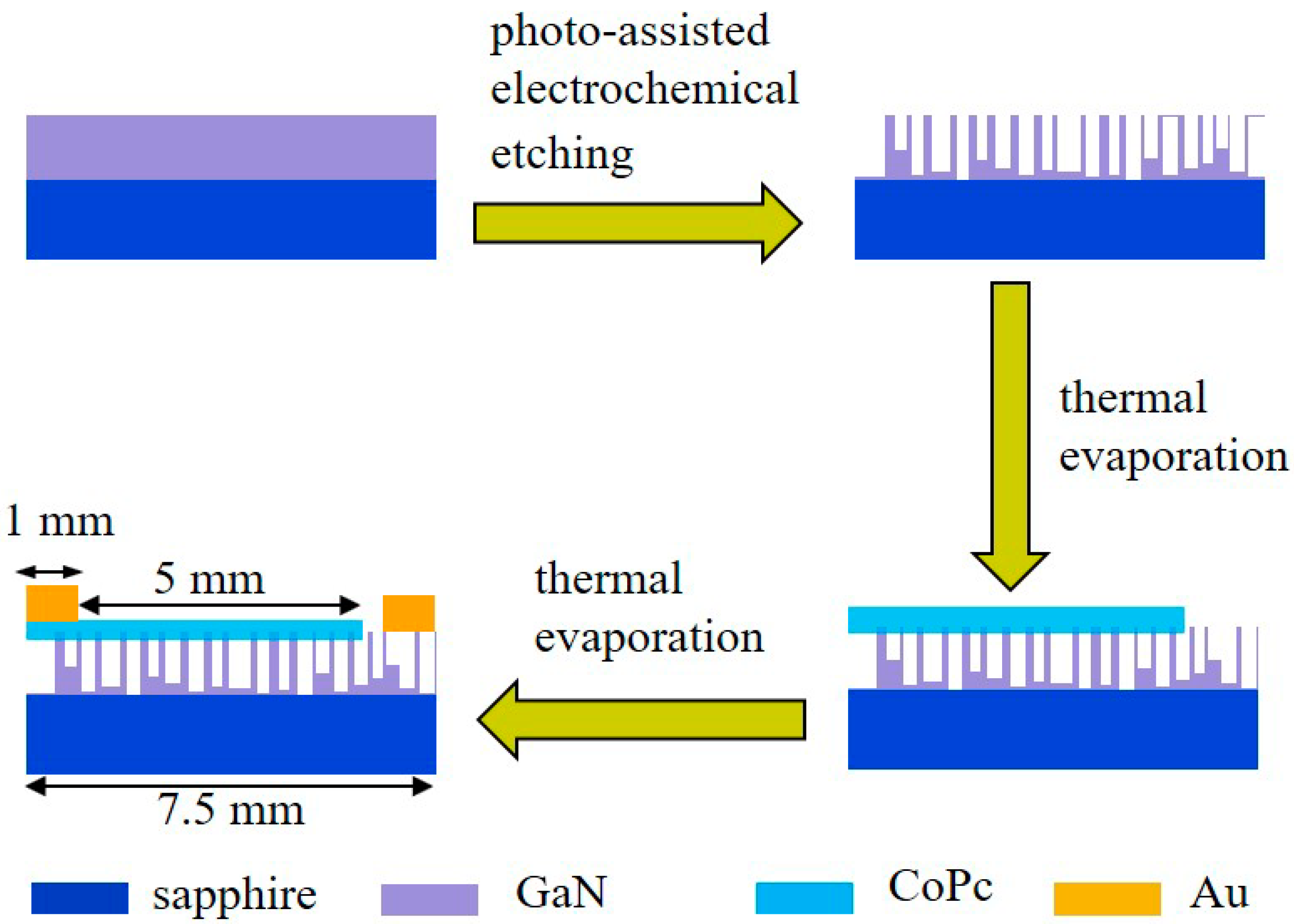
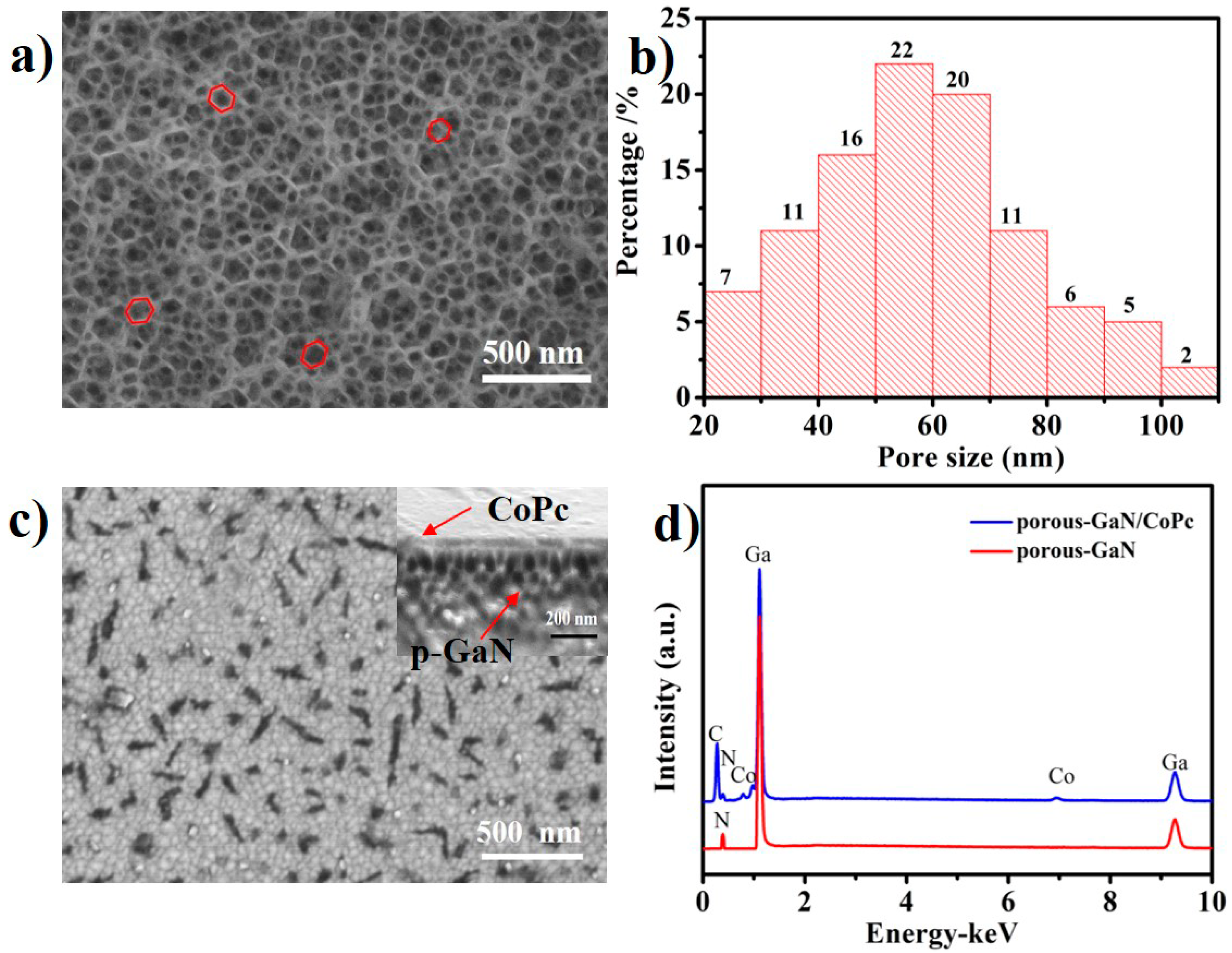
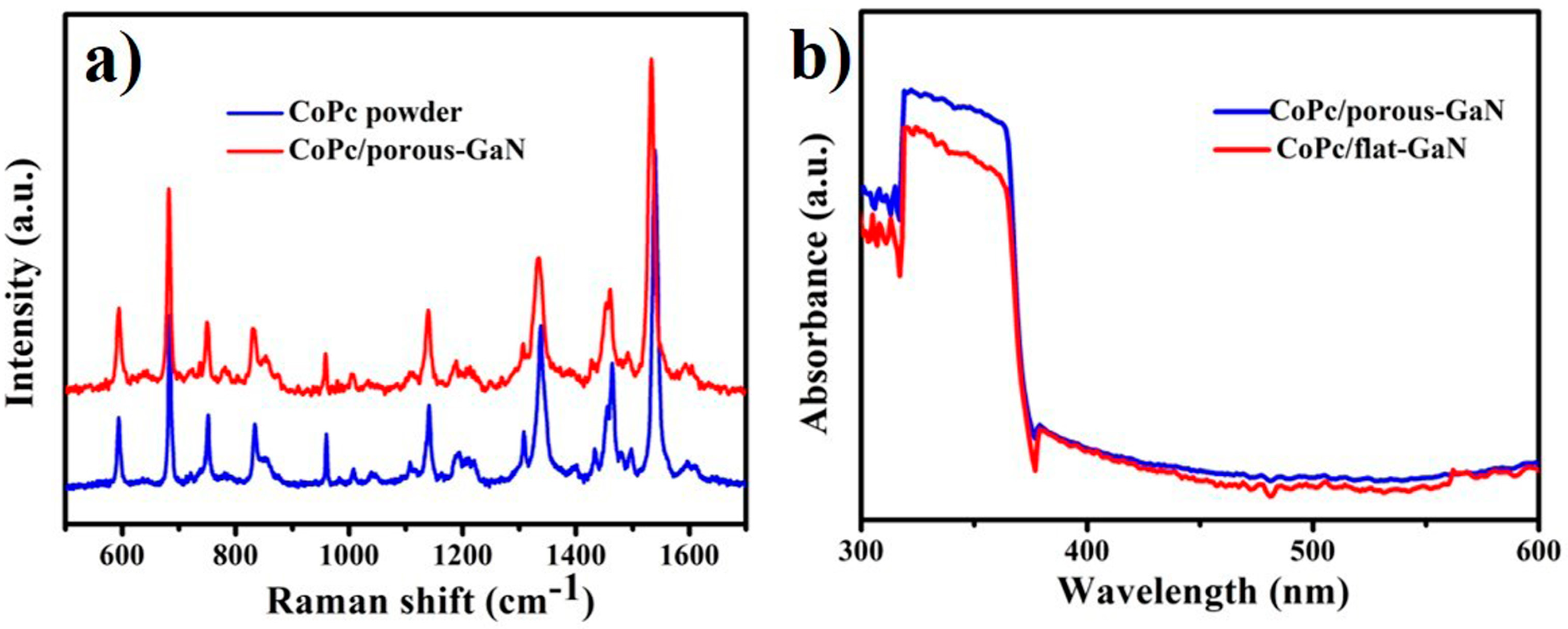
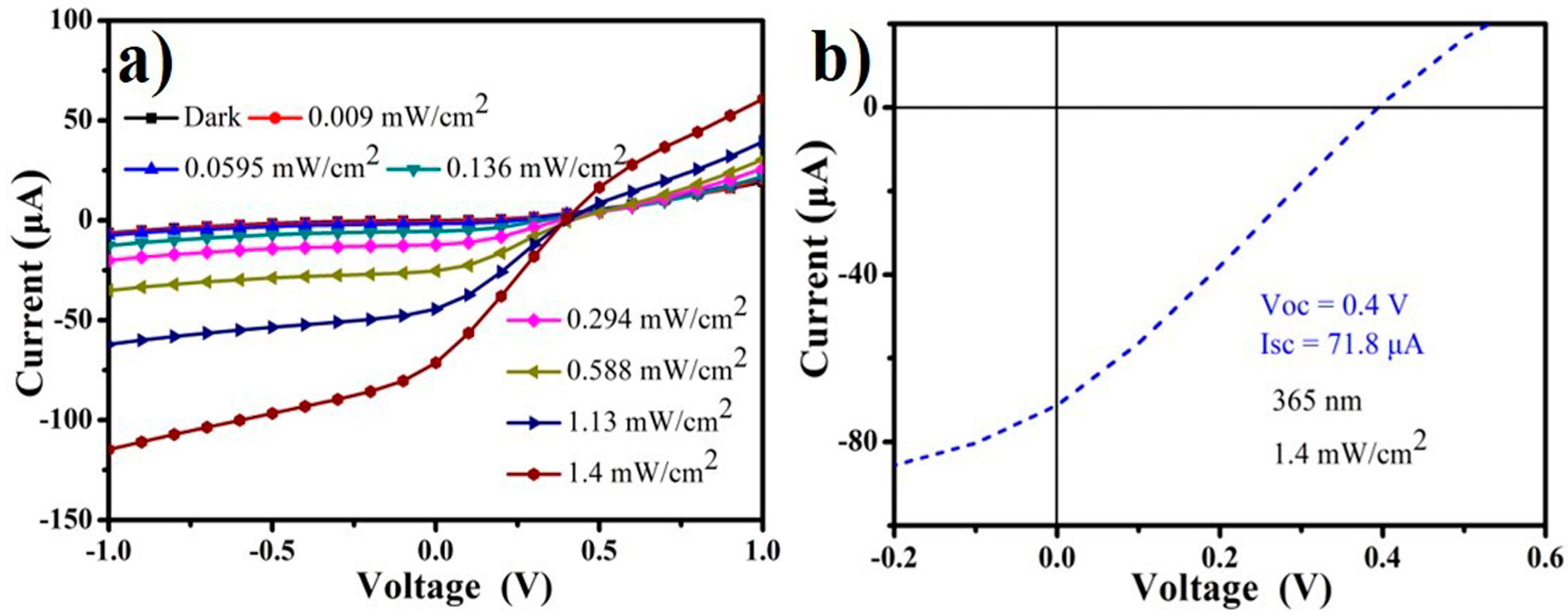
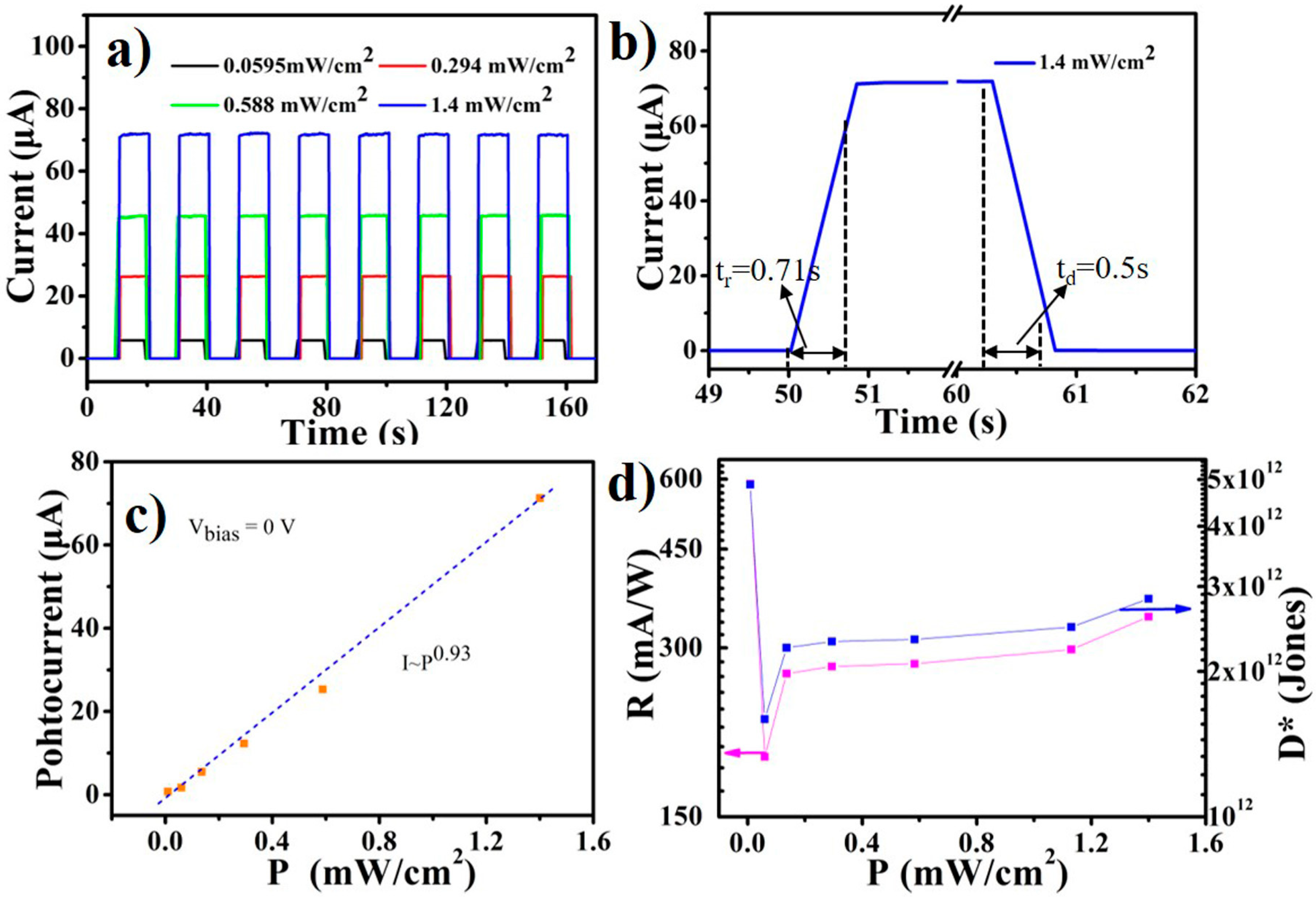


| Materials | Light Source | Switch Ratio | Responsivity (mA/W) | Detectivity (Jones) | Reference |
|---|---|---|---|---|---|
| GaN/Si- nanoporous pillar array | 305 nm | ~104 | 29.4 | - | [10] |
| MoS2/GaN | 265 nm | ~105 | 187 | 2.34 × 1013 | [11] |
| Ga2O3/GaN | 365 nm | 152 | 54.49 | 1.23 × 1011 | [53] |
| n-GZO NRs/porous-GaN | 365 nm | ~105 | 230 | 2.32 × 1012 | [54] |
| CH3NH3PbI3/GaN | 365 nm | 5000 | 198 | 7.96 × 1012 | [38] |
| CoPc/porous-GaN | 365 nm | ~105 | 588 | 4.8 × 1012 | This work |
© 2019 by the authors. Licensee MDPI, Basel, Switzerland. This article is an open access article distributed under the terms and conditions of the Creative Commons Attribution (CC BY) license (http://creativecommons.org/licenses/by/4.0/).
Share and Cite
Xiao, Y.; Liu, L.; Ma, Z.-H.; Meng, B.; Qin, S.-J.; Pan, G.-B. High-Performance Self-Powered Ultraviolet Photodetector Based on Nano-Porous GaN and CoPc p–n Vertical Heterojunction. Nanomaterials 2019, 9, 1198. https://doi.org/10.3390/nano9091198
Xiao Y, Liu L, Ma Z-H, Meng B, Qin S-J, Pan G-B. High-Performance Self-Powered Ultraviolet Photodetector Based on Nano-Porous GaN and CoPc p–n Vertical Heterojunction. Nanomaterials. 2019; 9(9):1198. https://doi.org/10.3390/nano9091198
Chicago/Turabian StyleXiao, Yan, Lin Liu, Zhi-Hao Ma, Bo Meng, Su-Jie Qin, and Ge-Bo Pan. 2019. "High-Performance Self-Powered Ultraviolet Photodetector Based on Nano-Porous GaN and CoPc p–n Vertical Heterojunction" Nanomaterials 9, no. 9: 1198. https://doi.org/10.3390/nano9091198



